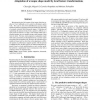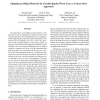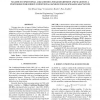112
Voted
ICASSP
2011
IEEE
14 years 4 months ago
2011
IEEE
This paper describes subspace constrained feature space maximum likelihood linear regression (FMLLR) for rapid adaptation. The test speaker’s FMLLR rotation matrix is decomposed...
122
Voted
ICASSP
2011
IEEE
14 years 4 months ago
2011
IEEE
In this paper, we propose a novel method for rapid feature space Maximum Likelihood Linear Regression (FMLLR) speaker adaptation based on bilinear models. When the amount of adapt...
98
Voted
ICASSP
2011
IEEE
14 years 4 months ago
2011
IEEE
We propose an environment population projection (EPP) approach for rapid acoustic model adaptation to reduce environment mismatches with limited amounts of adaptation data. This a...
109
click to vote
INTERSPEECH
2010
14 years 7 months ago
2010
Reconstructing the full contour of the tongue from the position of 3 to 4 landmarks on it is useful in articulatory speech work. This can be done with submillimetric accuracy usin...
85
Voted
INTERSPEECH
2010
14 years 7 months ago
2010
This paper investigates the combination of discriminative adaptation techniques. The discriminative Maximum A-Posteriori (DMAP) adaptation and discriminative feature Maximum Likel...
97
Voted
INTERSPEECH
2010
14 years 7 months ago
2010
Linear regression based speaker adaptation approaches can improve Automatic Speech Recognition (ASR) accuracy significantly for a target speaker. However, when the available adapt...
147
Voted
CVPR
2011
IEEE
14 years 8 months ago
2011
IEEE
The performance of an offline-trained classifier can be improved on-site by adapting the classifier towards newly acquired data. However, the adaptation rate is a tuning parame...
107
click to vote
ICASSP
2008
IEEE
15 years 7 months ago
2008
IEEE
This paper shows how to improve Hidden Conditional Random Fields (HCRFs) for phone classification by applying various speaker adaptation techniques. These include Maximum A Poste...



